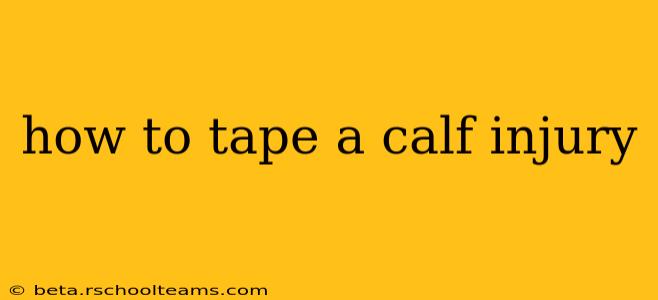Calf injuries, ranging from minor strains to more serious tears, are common, especially among athletes and individuals involved in physically demanding activities. Knowing how to properly tape a calf injury can provide crucial support, reduce pain, and aid in the healing process. However, it's vital to remember that taping is a supportive measure and not a replacement for proper medical evaluation and treatment. This guide will walk you through the process, but always consult a doctor or physical therapist for diagnosis and personalized advice.
What are the Different Types of Calf Injuries?
Before we delve into taping techniques, understanding the types of calf injuries is crucial. This helps determine the appropriate level of support needed. Common calf injuries include:
- Muscle Strain: This involves a tear in the muscle fibers, ranging from mild (Grade 1) to severe (Grade 3). Grade 3 strains often require more extensive medical intervention.
- Muscle Tear: A more significant injury than a strain, involving a complete rupture of the muscle.
- Tendinitis: Inflammation of the tendons in the calf (usually the Achilles tendon or plantar fascia).
- Calf Cramps: Intense, involuntary muscle contractions. While not technically an injury requiring taping in the same way, taping can help prevent recurrence.
How to Determine the Severity of Your Calf Injury?
Assessing the severity of your injury is critical before attempting any taping. Consider these factors:
- Pain Level: Is the pain mild, moderate, or severe?
- Swelling: Is there significant swelling around the injured area?
- Bruising: Is there any discoloration (bruising)?
- Range of Motion: Can you move your ankle and foot normally?
- Ability to Bear Weight: Can you walk comfortably on the injured leg?
If you experience severe pain, significant swelling, inability to bear weight, or suspect a severe tear, seek immediate medical attention.
What Supplies Do I Need to Tape a Calf Injury?
To effectively tape a calf injury, you'll need:
- Athletic Tape: This is specifically designed for athletic use and offers strong support without restricting blood flow. Avoid using household tape.
- Underwrap: This thin, cotton layer protects the skin from irritation and helps the athletic tape adhere better.
- Scissors: Sharp scissors for clean cuts.
- Optional: Ice Pack and Compression Bandage: Using ice and a compression bandage before taping can reduce swelling.
Step-by-Step Guide: How to Tape a Calf Injury for Support
This guide provides a general approach. Your specific taping technique might need adjustment based on the location and severity of your injury. It's always best to consult a professional for personalized instruction.
- Prepare the Area: Clean and dry the skin. Apply underwrap to protect the skin and improve tape adhesion.
- Anchor the Tape: Start by anchoring the tape above the injured area, wrapping it around the leg once or twice.
- Apply Support Strips: Apply strips of tape, pulling them taut but not excessively tight. Direct these strips to support the injured muscle, typically running from below the knee to just above the ankle. The angle and number of strips will depend on the injury's location and severity. Overlap each strip by about half its width.
- Secure the Tape: Finish by anchoring the tape at the bottom, overlapping the previous strips.
- Check for Comfort and Circulation: Ensure the tape is snug but not constricting. Check your toes for adequate circulation (they should be pink and warm).
How Long Should I Keep the Tape On?
The length of time you should keep the tape on depends on the severity of the injury and your comfort level. Generally, it shouldn't be worn for more than 24 hours. Remove the tape gently to avoid skin irritation. If you experience increased pain, numbness, or tingling, remove the tape immediately.
When Should I See a Doctor About My Calf Injury?
You should seek medical attention if:
- You experience severe pain.
- There's significant swelling or bruising.
- You can't bear weight on your leg.
- You have numbness or tingling in your foot.
- The pain doesn't improve after a few days of rest and ice.
- You suspect a possible fracture.
Can I Tape a Calf Injury Myself?
While this guide provides general instructions, self-taping might not be appropriate for all calf injuries. If you're unsure, seek professional guidance from a doctor or physical therapist. They can assess your injury accurately and provide tailored advice, including appropriate taping techniques and rehabilitation strategies. They can also teach you how to prevent future calf injuries.
Remember, this information is for general knowledge and does not substitute professional medical advice. Always consult a healthcare professional for diagnosis and treatment of any injury.
